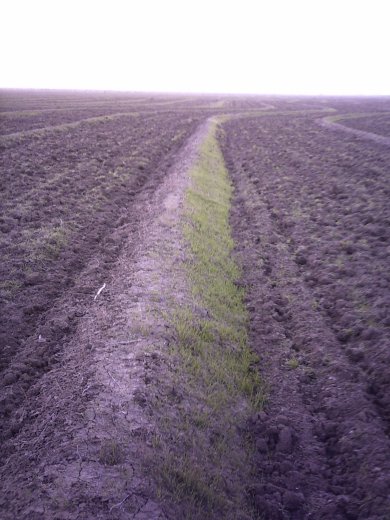|
|
Land Retirement Demonstration Project |
|
LRDP Home | Land Retirement | Habitat Restoration Study | Valley Flora Propagation Center | Restoration Research | Data and Links | ESRP Home |
|

Figure 1. An example of the curvilinear berms that were installed on the northernmost 80 acres of the North Avenue Parcel.
Note that while this particular photograph offers a good look at the form of the berms, it does
not show any of the areas where the imprinted vegetation was well-established.
THE SEED DELIVERY AND COMPETITION TRIAL
Overview
The Seed Delivery and Competition Trial was situated on the northernmost portion of the North Avenue Property. Restoration efforts had previously been applied to this area; however, almost all of the native vegetation that was established from these efforts was situated on the berms (and adjacent trenches).
The Seed Delivery and Competition Trial was developed in order to compare two seed delivery methods (imprinting and drilling). An additional treatment factor, seed mixture, was incorporated into the trial. Two seed mixtures, the "Phacelia mixture" and the "Late-season Mixture" were compared. Seeding took place only on the "flats" (i.e., the portion between berms), as establishment of the previously seeded species was deemed sufficient on the berms to preclude re-seeding. Each flat was treated as an experimental plot. Treatments (i.e., the four seed delivery-seed mixture combinations) were assigned randomly in a complete randomized block design; each treatment was replicated eight times (32 plots total).
The "Phacelia Mixture" (eight species; Table 1) had a substantial component of Phacelia ciliata (great valley Phacelia), an early-germinating native forb that has shown promise in the Native Plant Nursery and in various restoration trials. It was hoped that P. ciliata would be able to successfully compete with the annual winter grasses that dominate much of the North Avenue Property. Phacelia ciliata possesses a spreading habit; as the species dies back during the summer months, the stems disarticulate creating open habitat. A number of the remaining species in this seed mixture were late-germinating perennials. It was hoped that these species would be able to become established in the (theoretical) open spaces formerly occupied by P. ciliata.
The "Late-season Mixture" (seven species; Table 1) was composed entirely of late-season species. The areas seeded with this mixture will be treated with herbicide in the early spring (i.e., before any of the seeded species are expected to germinate), in order to create suitable conditions for the establishment of the seeded species.
Originally, it was intended that seeding would occur shortly after the first rains. In this way, it was hoped that seeding would precede germination of the winter weeds. However, in the fall of 2004 the initial rains were followed by periodic rainy periods, such that during an approximately six week long period the soil never dried sufficiently to allowed seeding. Therefore, when conditions finally allowed seeding, the winter weeds (specifically, the non-native grasses) had developed sufficiently to allow them a distinct advantage over the seeded species. To control the weeds, seeding was proceeded by worked the soil with a hook-chisel. Seeding took place on 22 November, 2004 (imprinting) and 2-3 December (broadcasting).
Table 1. Species imprinted in the Seed Delivery and Competition Trial, including family, common name, life-form, and seeding rates for the two seed mixtures. Seeding rates are expressed as pure live seeds per square foot (PLS/ft2); species whose seeding rate are indicated by a plus sign are those for which viability and purity data were unavailable; hence their P.L.S. seeding rate was not known. Key to Treatments: PH, Phacelia Mixture; LS, Late-season Mixture.
| Taxon | Family | Common Name | Life-form | PH | LS |
|---|---|---|---|---|---|
| Allenrolfea occidentalis | Chenopodiaceae | iodinebush | shrub | 14.00 | 14.00 |
| Atriplex coronata | Chenopodiaceae | crownscale | annual herb | + | |
| Atriplex polycarpa | Chenopodiaceae | allscale saltbush | shrub | 15.00 | 15.00 |
| Grindelia camporum | Asteraceae | gumplant | perennial herb | 0.33 | |
| Heliotropium curassavicum | Boraginaceae | seaside heliotrope | perennial herb | 17.00 | 18.00 |
| Hemizonia pungens | Asteraceae | common spikeweed | annual herb | 7.00 | |
| Holocarpha obconica | Asteraceae | San Joaquin tarweed | annual herb | + | |
| Layia glandulosa | Asteraceae | white layia | annual herb | 5.00 | |
| Monolopia stricta | Asteraceae | Crum's monolopia | annual herb | + | |
| Phacelia ciliata | Hydrophyllaceae | Great Valley phacelia | annual herb | 25.00 | |
| Sesuvium verrucosum | Aizoaceae | western sea-purslane | perennial herb | 10.00 | 3.50 |
Page created: March 1, 2005; Last updated: Dec. 20, 2005